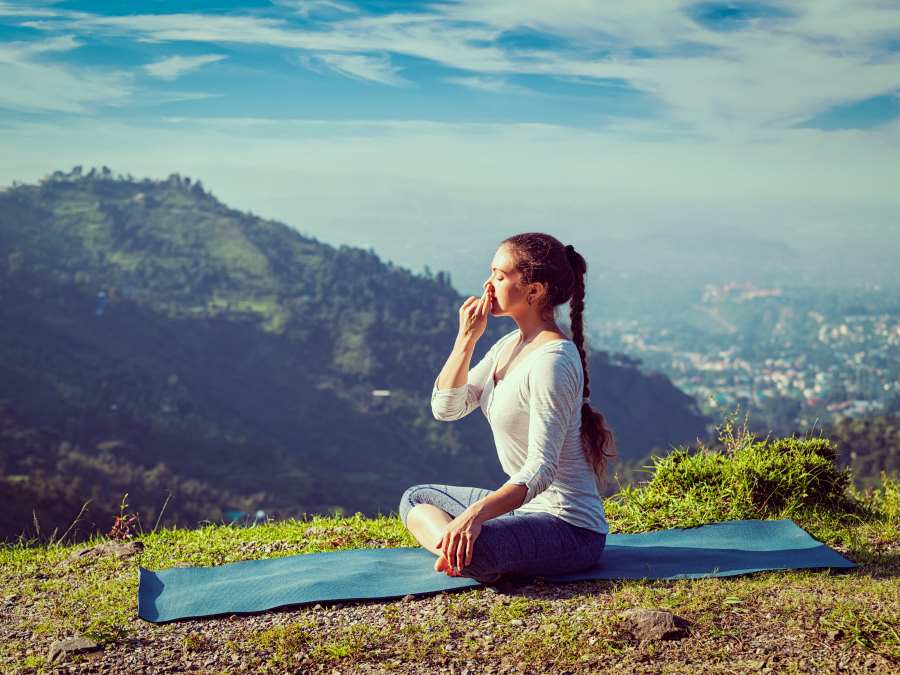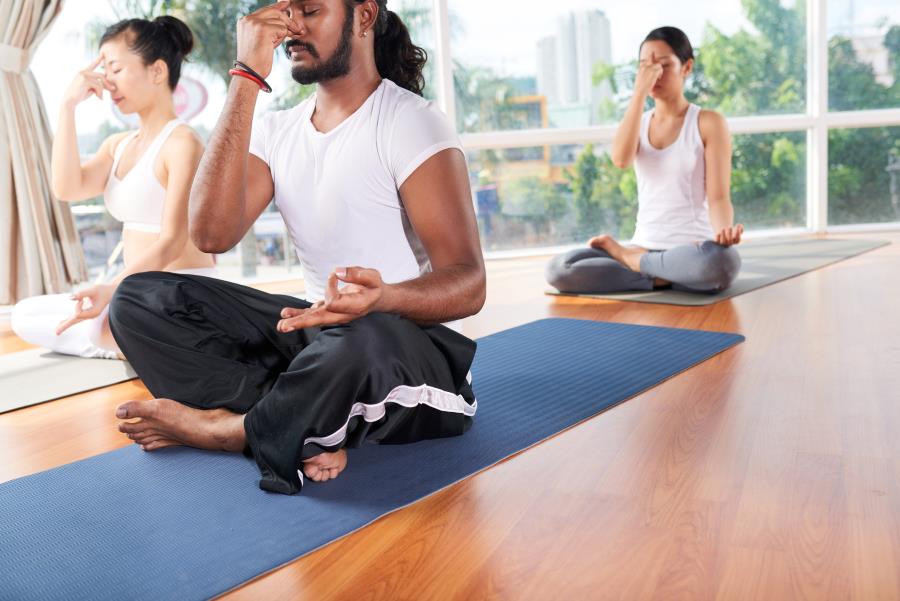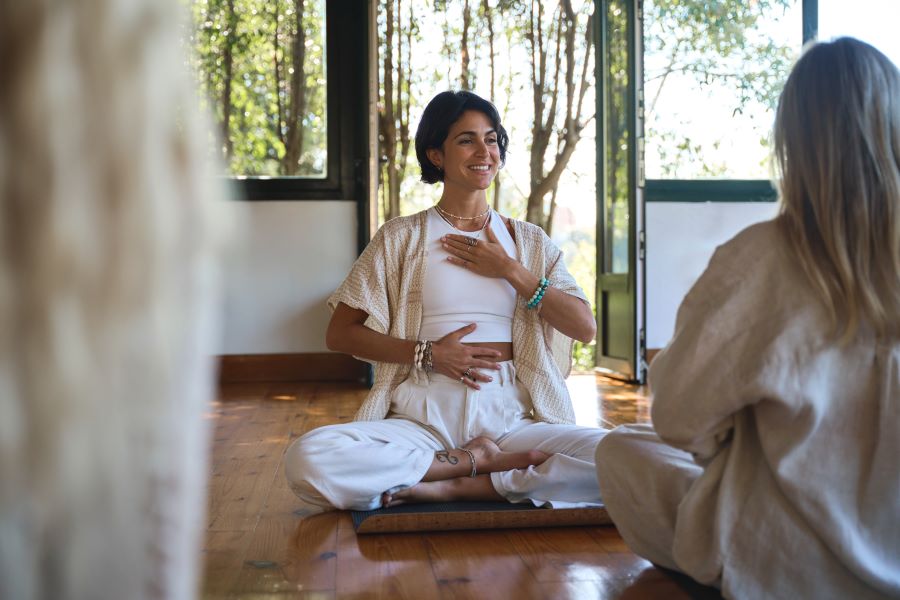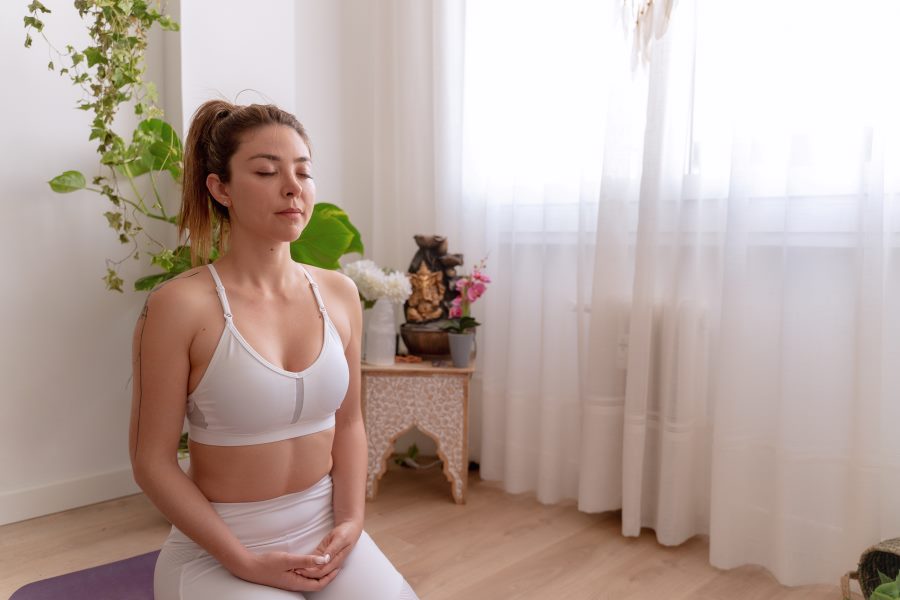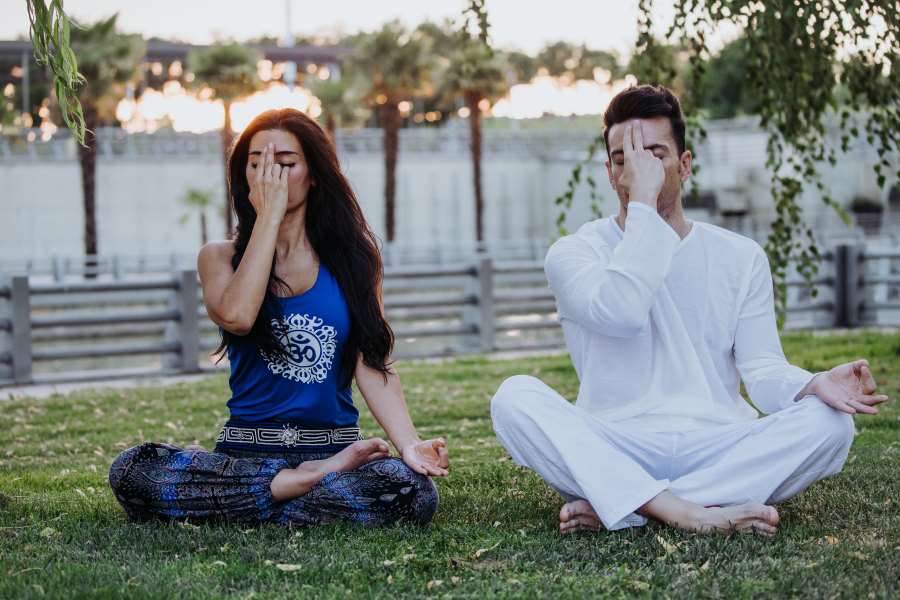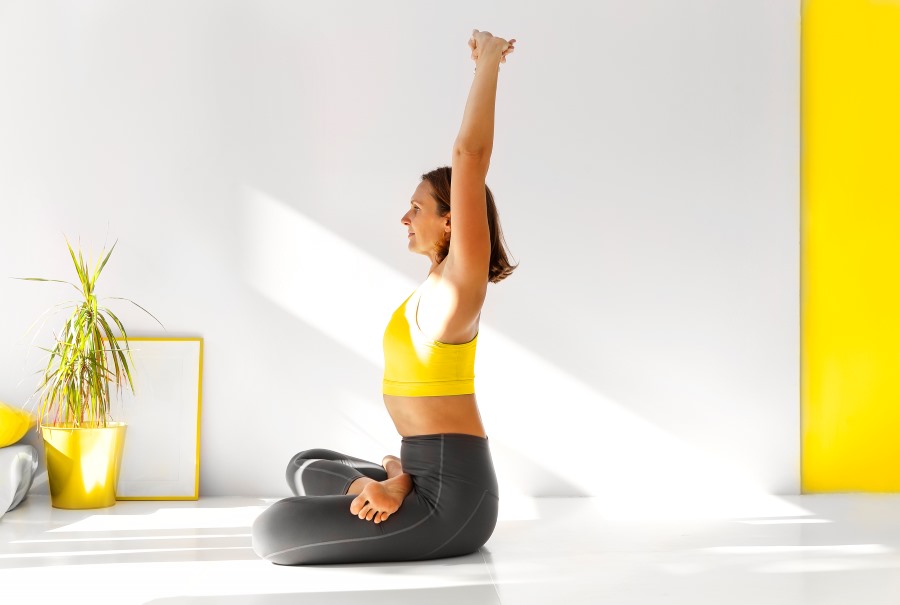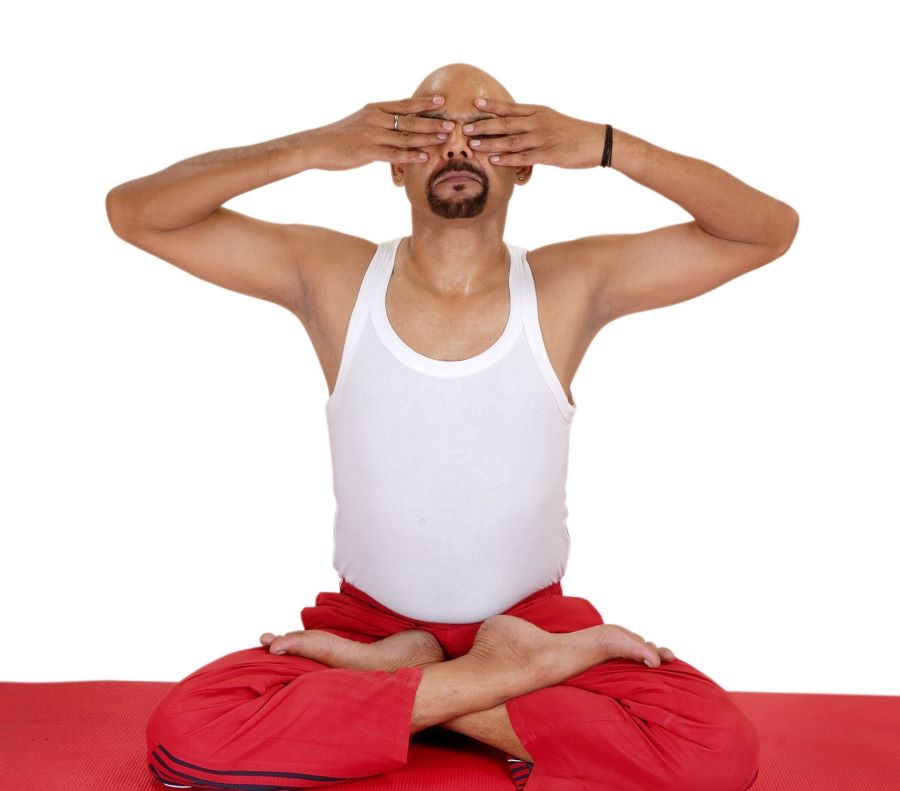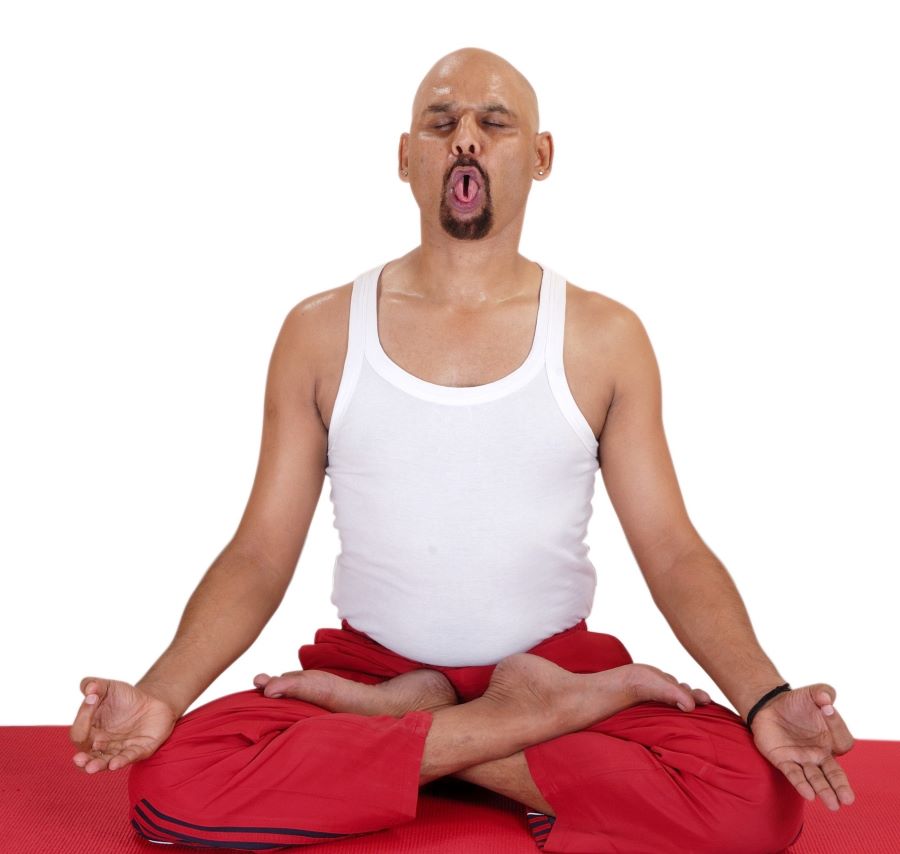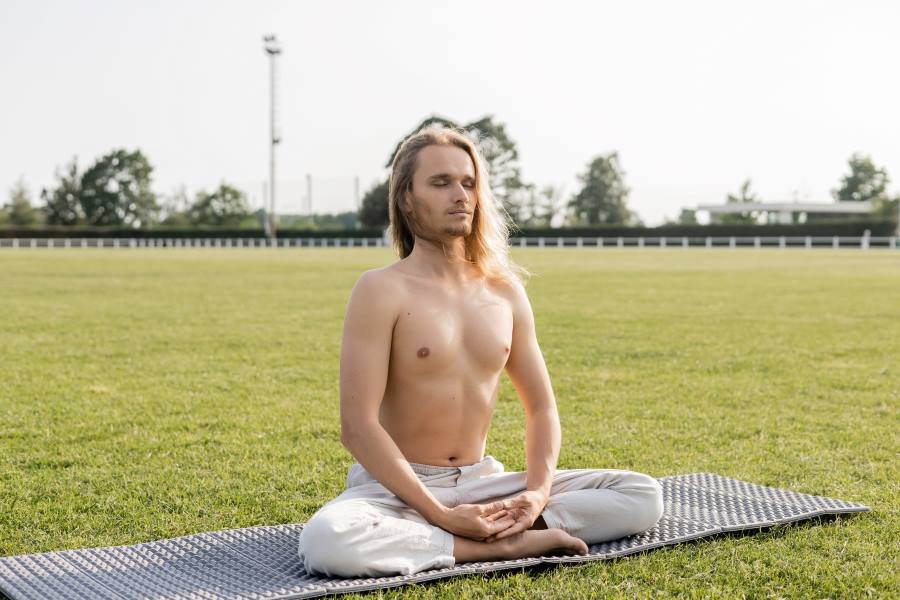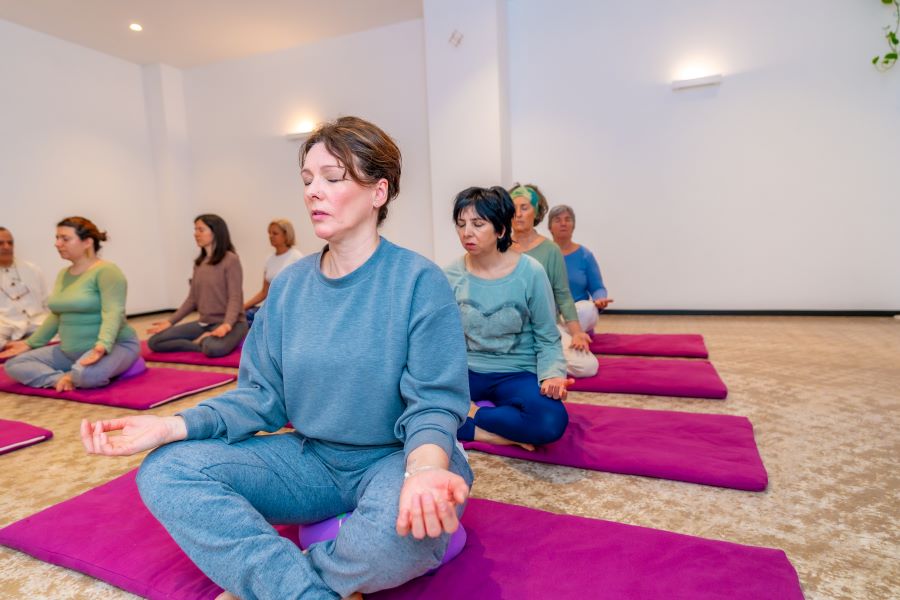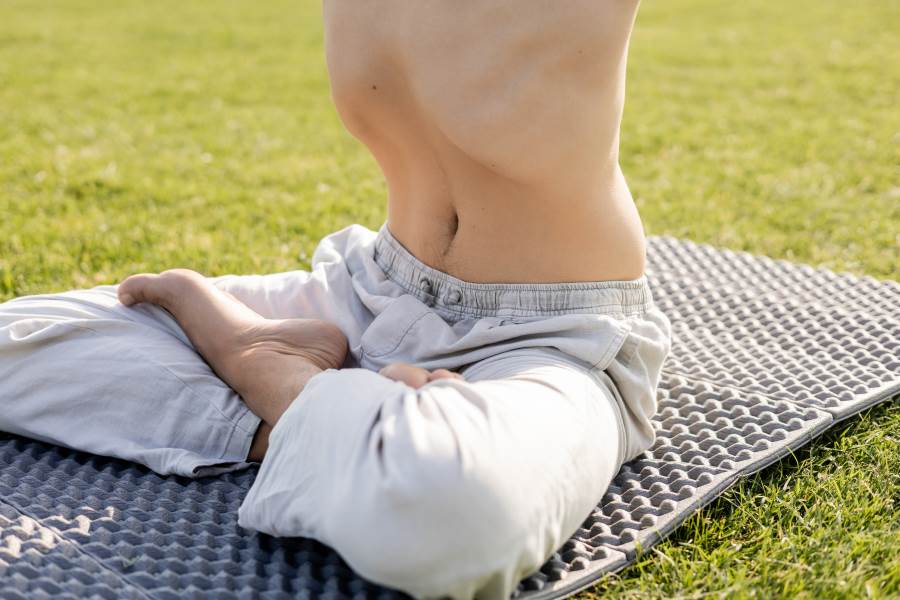Generally, while performing any Pranayama, instructors suggest that individuals sit in a comfortable meditative position. Individuals are further advised to keep their spine and head straight so they fall in one straight line. Moreover, one should practice this breathing exercise on an empty stomach for this technique to be effective.
Here are the various types of Pranayama techniques:
1. Dirga Pranayama
This is full yogic breathing with a three-part breathing technique. It is one of the most basic types of breathing exercises and is perfect for beginners. Practising Dirga Pranayama will help individuals correct their irregular breathing habits.
Origin: This word originated from a Sanskrit word, "Dirgha", which means long.
Benefits:
Below are a few benefits of the Dirga Pranayama:
- It stimulates your endorphins and elevates your mood.
- This breathing exercise will increase anti-ageing hormones in your body.
- Dirga Pranayama relieves stress and anxiety.
- Promotes deep, full breathing, improving lung capacity and oxygen intake.
- Reduces stress and anxiety by calming the nervous system.
- Enhances focus and mental clarity, aiding in mindfulness practices.
- Improves circulation and helps detoxify the body.
- Balances emotions and promotes a sense of inner peace.
- Supports better sleep by promoting relaxation.
- Strengthens the respiratory system, benefiting overall health.
How to Perform:
To perform Dirga Pranayama, follow these steps:
- Step 1: You need to observe the natural flow of your breathing in the beginning.
- Step 2: Place one hand on your belly and the other on your chest.
- Step 3: Take a deep breath and try to feel your belly, which will fill up with air.
- Step 4: Inhale more air to feel your ribcage expand
- Step 5: The final step is to feel your breath and your clavicles.
- Step 6: Repeat these steps 3-5 times.
2. Sama Vriti
While performing this Pranayama, one tries to align the length of each inhalation and exhalation. This breathing exercise helps the individual reach a state of deep relaxation, nourishing one's soul. Since it is performed with four different stages, people sometimes use the term "square box breathing" to describe Sama Vriti.
Origin: The name for this exercise originated from two Sanskrit words, "Sama" and "Vriti". These terms mean equal and flow, respectively.
Benefits:
Below are a few benefits of the Sama Vriti:
- Equalises, balances, and harmonises an individual's prana in his/her body's energy channel
- Helps reduce mental stress
- Consciously makes an individual use the diaphragm
- Reduces stress and anxiety with controlled, rhythmic breathwork.
- Improves lung capacity and respiratory efficiency over time.
- Promotes emotional stability and overall mental well-being.
- Balances the autonomic nervous system for better health.
- Supports relaxation and deeper meditation practices effectively.
- Regulates the heart rate and promotes cardiovascular health.
How to Perform:
To perform Sama Vriti, follow these steps:
- Step 1: For at least four seconds, inhale deeply from your nostrils.
- Step 2: Then hold your breath for 4 seconds more.
- Step 3: Furthermore, exhale for 4 seconds.
- Step 4: Finally, hold your breath for 4 seconds after exhaling.
- Step 5: Repeat these steps 5 times.
3. Viloma Pranayama
This kind of Pranayama is suitable for beginners as one can do this exercise lying down or sitting in a meditative position. Viloma Pranayama will help one calm his/her mind and completely relax the nervous system. Regular yoga practitioners often perform this exercise before or after they begin their meditation or any other form of Yoga so that they can calm their minds.
Origin: This exercise originated from Sanskrit words "Vi" and "Loma", which mean contrary to and hair, respectively. So, it means going against the grain.
Benefits:
Below are a few benefits of the Viloma Pranayama:
- Helps to reduce anxiety and tension
- Boosts your lung capacity
- Energise and cool your mind and body
- Boosts overall emotional well-being and reduces anxiety levels.
- Encourages a balanced flow of energy throughout the body.
- Supports detoxification by promoting efficient elimination of toxins.
How to Perform:
To perform Viloma Pranayama, follow these steps:
- Step 1: Sit in a reclined position and face skywards.
- Step 2: The first step is to inhale as much air as possible. It should be at least a third of your lung's capacity.
- Step 3: After inhaling, pause for 2-3 seconds.
- Step 4: Again, inhale for two more seconds after the pause. Continue these 3 more times or up until your lungs are filled with air.
- Step 5: Exhale the air, but use your nostrils to control the exhalation.
- Repeat the above steps 4-5 times.
4. Nadi Shodhana
People often use the term ‘Anuloma Vyloma’ or alternate breathing to refer to this breathing technique. This exercise is great for balancing all the energies inside one's body. It balances all three doshas in one's body.
Origin: Nadi is a Sanskrit term which means channel, and Shodhana translates to purification.
According to Ayurveda, the main aim of these techniques is to clean all three Nadis in one's body. These Nadis are- Ida, Pingala and Sushumna.
Benefits:
- Below are a few benefits of the Nadi Shodhana:
- Brings Ida and Pinghala to an equilibrium
- Helps you to cleanse your pranic channels, which in turn vitalises these channels.
- Spiritually awakens the dormant energies in your body.
- Improves respiratory function and increases lung capacity.
- Enhances focus and concentration during meditation and daily tasks.
- Boosts overall emotional well-being and reduces anxiety levels.
- Encourages a balanced flow of energy throughout the body.
- Supports detoxification by promoting efficient elimination of toxins.
How to Perform:
To perform Nadi Shodhana, follow these steps:
- Step 1: You need to sit in a comfortable position with your legs crossed.
- Step 2: Before starting the exercise, raise your right hand to make the Vishnu mudra.
- Step 3: Close your right nostril with your thumb and breathe slowly from your left nostril. Make sure you take your breaths consciously and count to four. You can also increase the counts with time.
- Step 4: Then close your left nostril with your ring finger and exhale from your right nostril.
- Step 5: For four seconds, breathe in from the same nostril and then close your right nostril.
- Step 6: Finally, breathe out from your left nostrils.
After completing one round, you can repeat these steps a few more times.
5. Bhastrika Pranayama
You must rapidly inhale and exhale while performing this breathing exercise. This exercise aims to create rhythmic breathing, and they are typically fast-paced. As a result, your diaphragm will stimulate movements like that of a pair of bellows.
Origin: Bhastrika originated from a Sanskrit word that translates to bellows.
Benefits:
- Below are a few benefits of the Bhastrika Pranayama:
- Flushes out toxins from the human body and improves circulation
- Clears out one's nasal passage, which helps in alleviating allergies
- Promotes glowing skin
- Improves your lung capacity
- Improves focus and concentration during meditation practices.
- It supports detoxification by purifying the body’s systems.
How to Perform:
To perform Bhastrika Pranayama, follow these steps:
- Step 1: Relax your body before beginning this Pranayama.
- Step 2: Raise both your hands in the air and forcefully breathe from your nose.
- Step 3: Now, put your hands down and breathe with the same intensity with your nose.
- Repeat these steps up to 20 times.
6. Bhramari Pranayama
To perform this breathing technique, you need to create a humming sound while breathing. The vibrations that these sounds generate create a soothing sensation for practitioners. This low-pitched humming sound resembles a bee's buzzing.
Origin: Bhramari originated from an ancient Sanskrit word, "Bhramar".
Benefits:
Below are a few benefits of the Dirga Pranayama:
Helps in reducing insomnia, stress, anxiety and anger
Extremely useful for pregnant women who are in labour
Promotes regeneration of tissues in one's body
How to Perform:
To perform Dirga Pranayama, follow these steps:
- Step 1: Raise both your arms and then close your ears.
- Step 2: While inhaling through your nose, create a smooth humming sound.
- Step 3: During exhalation, create the same sound.
- Repeat the same steps up to 11 times.
7. Sheetali Pranayama
Practitioners use the cooling breath to perform this type of Pranayama. Practising Sheetali Pranayama will help cool you down on a warm summer day. Additionally, it will soothe your muscles and nervous system.
Origin: This term originated from the Sanskrit word "Sheetal", which means cool and calm.
Benefits:
Below are a few benefits of the Sheetali Pranayama:
- Aims to balance out the Pitta in your body
- Stimulates your digestive fire and improves digestion
- Cools down the excess amount of heat in your body
- Helps to reduce anxiety
- Cools the body, reducing heat and inflammation.
- Calms the mind, promoting mental clarity and peace.
- Aids in digestion by stimulating digestive functions.
- Reduces stress and anxiety through controlled breathing.
How to Perform:
To perform Sheetali Pranayama, follow these steps:
- Step 1: Open your mouth and roll your tongue in a slight tube, sort of in shape.
- Step 2: Breathe in from your mouth, and once you feel you have reached the maximum limit, close your mouth.
- Step 3: Then, exhale from your nose.
You can keep repeating this process as many times as you need or till the time you have cooled down.
8. Ujjayi Pranayama
This exercise is similar to the ocean waves. Moreover, yoga instructors consider this exercise one of the best breathing techniques to cool off one's mind and body. Ujjayi Pranayama, also known as the "Victorious Breath," involves deep, slow breathing with a slight constriction in the throat. It creates a soothing sound, helping to calm the mind and body.
Origin: Ujjayi is an amalgamation of 2 Sanskrit terms. The first one is "Uj", which means expand, and the second is "Jaya", which means conquest. This exercise mainly focuses on expanding all organs in one's body.
Benefits:
Below are a few benefits of the Ujjayi Pranayama:
- This exercise helps in detoxifying your body.
- Practising this Pranayama will help you keep your BP and thyroid in check.
- It calms and aids in rejuvenating your nervous system.
- Helps balance the nervous system and emotional well-being.
- Increases energy levels and overall physical vitality.
- Aids in detoxification by stimulating deeper breath processes.
- Supports better sleep quality by calming the mind.
How to Perform:
To perform Ujjayi Pranayama, follow these steps:
- Step 1: Sit comfortably in a cross-legged position.
- Step 2: Inhale oxygen from your mouth, but make sure to keep your throat constricted.
- Step 3: Focus on producing a hissing sound while you are inhaling.
- Step 4: Then close your mouth, slowly exhale from your nostrils, and keep your throat constricted.
- Step 5: Keep repeating these steps until you do not feel any strain while performing the exercises.
9. Kapalabhati Pranayama
Many people also refer to this Pranayama as the breath of fire, and its main aim is to build heat in one's body. It also increases vibrational energy in an individual's pranic body. Kapalabhati Pranayama, often called "Skull Shining Breath," is a powerful breathing technique that involves forceful exhalations and passive inhalations.
Origin: This term means shining skull in Sanskrit, and it is one of the most powerful and deep cleansing Pranayama amongst all the other Pranayama kinds.
Benefits:
Below are a few benefits of the Kapalabhati Pranayama:
- Helps in losing weight
- Promotes glowing skin
- Treats sinuses by removing mucus and also reduces asthma
- It will help get rid of constipation
- Cleanses nasal passages and improves overall sinus health.
- Boosts mental clarity and cognitive function.
- Stimulates digestion and helps with metabolic processes.
- Increases energy levels and reduces fatigue.
- Aids in detoxifying the body and improving immunity.
- Reduces stress and promotes a sense of calm.
How to Perform:
To perform Kapalbhati Pranayama, follow these steps:
- Step 1: Contract your abdominal muscles and exhale forcefully from your nose.
- Step 2: Next, inhale air passively.
- Step 3: Complete at least 30 to 60 rounds of this technique. Make sure you take small breaks in between so that you do not feel dizzy.
- Step 4: After completing the steps, get back to regular breathing.
10. Surya Bhedana Pranayama
This is another popular Pranayama technique often taught in Kundalini yoga classes. It will help you to awaken your Kundalini Shakti. This practice energises, stimulates the body's warming energy, and enhances mental clarity. It's ideal for boosting vitality and activating the body's internal heat.
Origin: Surya is the Sanskrit term for Sun, and it is connected to Pingala Nadi in one's body.
Benefits:
Below are a few benefits of the Surya Bhedana Pranayama:
- This exercise gets rid of all your Vata-related ailments.
- It helps to replenish oxygen in your blood and energises your body.
- Helps alleviate sinus congestion and respiratory issues.
- Increases overall vitality and combats fatigue effectively.
- Boosts body temperature and supports circulation processes.
- Strengthens the nervous system and improves mental resilience.
How to Perform:
To perform Surya Bhedana Pranayama, follow these steps:
- Step 1: Make the Nasarga mudra with your fingers.
- Step 2: Close your right nostril with your thumb.
- Step 3: Inhale slowly through your left nostrils.
- Step 4: Close your left nostril with your ring finger.
- Step 5: Breathe out from your right nostril.
Repeat these steps for at least 20 rounds.
11. Chandra Bhedana Pranayama
It is believed that a human's left side is believed to be associated with lunar energy, and practising this technique will allow you to feel a cooling effect in your body. Chandra Bhedana Pranayama, or the "Moon Piercing Breath," involves inhaling through the left nostril and exhaling through the right.
Origin: This Pranayama got its name from a Sanskrit word which means Moon.
Benefits:
Below are a few benefits of the Chandra Bhedana Pranayama:
- This exercise reduces blood pressure.
- If you practice this breathing exercise regularly, you will feel the coolness in your body.
- It will also reduce any mental stress and anxiety.
- Calms the mind and reduces stress and anxiety levels.
- Enhances mental clarity and improves focus and concentration.
- Balances body temperature and cools the system effectively.
- Aids in better sleep by promoting relaxation and calmness.
- Stimulates the parasympathetic nervous system for deep relaxation.
- Supports improved respiratory function and breath control.
- Promotes a sense of overall well-being and tranquillity.
How to Perform:
To perform Chandra Bhedana Pranayama, follow these steps:
- Step 1: Sit straight comfortably with your back straight and shoulders relaxed.
- Step 2: Close your right nostril with your right thumb and inhale from your left nostril.
- Step 3: Then, close your left nostril with your right hand's middle and index fingers.
- Step 4: Finally, exhale from your left nostrils.
You can repeat this for 20 rounds.
12. Simhasana Pranayama
Simhasana Pranayama, or "Lion's Breath," involves forceful exhalation with an open mouth and extended tongue, mimicking a lion's roar. This Yoga relieves tension and stretches out your facial muscles. Alongside, the face, tongue, and jaw are also stretched out. If you want to achieve a healthy glowing face, this is one of the best Pranayama exercises to practice.
Origin: The exercise gets its name from the Sanskrit word Simha, which means lion, which is why people often refer to it as the lion's breath.
Benefits:
Below are a few benefits of the Simhasana Pranayama:
- It prevents thyroid. So, if you are already a thyroid patient, this technique will help you manage it.
- It will help you exercise your chest and neck muscles.
- Boosts concentration and mental clarity during meditation.
- Strengthens the diaphragm and abdominal muscles effectively.
- Stimulates the throat chakra and improves voice quality.
- Promotes relaxation and reduces overall stress levels.
- Aids in improving posture and spinal alignment.
How to Perform:
To perform Simhasana Pranayama, follow these steps:
- Step 1: Sit comfortably in a meditative pose.
- Step 2: Inhale from your nose while making a "Ha" sound.
- Step 3: While exhaling, open your mouth as wide as possible.
- Step 4: Stick your tongue out towards your chin.
- Step 5: Finally, inhale and then relax your face.
Continue these steps at least 20 times.
13. Quiet Breathing
In Yoga, the regular breathing pattern which is relaxed and does not call for any kind of control is called quiet breathing. This is one of those Pranayama techniques that combine fast and deep breathing. It is often used as a foundational technique in meditation and mindfulness practices.
Origin: There is no record of this breathing technique's origins. However, many instructors use this technique during or after performing intense meditation.
Benefits:
Below are a few benefits of the Quiet Breathing:
- Slows down and increases heart rates.
- Helps in reducing blood pressure.
- Aids in calming down your mind.
- Improves focus by reducing mental distractions and stress.
- Supports better sleep through deep, steady breathing.
- Reduces anxiety by promoting a sense of calmness.
- Lowers blood pressure by encouraging slower, deeper breaths.
- Aids in digestion by stimulating the parasympathetic response.
- Boosts overall energy levels through efficient oxygen use.
How to Perform:
To perform Quiet Breathing, follow these steps:
- Step 1: To perform this Pranayama, you need to sit in a Savasana position.
- Step 2: Be aware and mindful of your surroundings.
- Step 3: After you start feeling comfortable, you can close your eyes if you wish to do so.
- Step 4: Try to notice and feel how you breathe. You will notice your breath significantly quiet down and become shallow.
You need to keep the in and out flow breathing as natural as possible without trying to force anything.
14. Deep Breathing
With this technique, one can regain his/her mind and body's tranquillity. This technique preaches practitioners to take deep and nourishing breaths, energising one's body and mind. Additionally, it will help in uplifting one's mood as well. It is commonly used to enhance focus and promote physical and mental well-being.
Origin: Similar to quiet breathing, the exact origin of deep breathing is also not known. However, instructors often suggest people perform this technique during stressful situations to understand the full potential of this technique.
Benefits:
Below are a few benefits of the Deep Breathing:
- Helps in improving your blood flow and immunity
- Calms down anxiety and helps you to sleep better
- Supports in improving your posture
- Reduces stress by calming the nervous system and mind.
- Enhances oxygen intake, improving overall energy and alertness.
- Lowers blood pressure, promoting better cardiovascular health naturally.
- It supports detoxification by aiding in the removal of toxins.
- Strengthens lung capacity, improving respiratory function and endurance.
- Improves focus and concentration by increasing mental clarity.
- Enhances emotional stability, fostering a sense of inner peace.
- Boosts the immune system by increasing oxygen and circulation levels.
How to Perform:
To perform Quiet Breathing, follow these steps:
- Step 1: You need to close your eyes and focus on your natural breathing patterns.
- Step 2: Take deep breaths till your lungs are filled with air.
- Step 3: Exhale air from your nose or mouth.
15: Tribandha
In this technique, practitioners are supposed to use certain actions to help them contract certain muscles. There are three types of locks in this method: Jalandhara Bandha, Moola Bandha and Uddiyana Bandha. All three locks make up the Maha Bandha or Tribandha.
Origin: Tribandha originated from the Sanskrit word "Bandha", which means a lock. In this Pranayama, one tries to lock one's throat, abdomen and perineum muscles.
Benefits:
Below are a few benefits of the Tribandha:
- One of the major benefits of this Pranayama is that it tones up one's glands, tissues, nerves and cells. As a result, one's body stays fit.
- Enhances energy flow by activating and balancing vital body locks.
- Improves digestion and elimination through internal organ stimulation and control.
- Promotes mental clarity and concentration by harmonising bodily energies.
- Strengthens core muscles, supporting posture and physical stability.
- Reduces stress and anxiety by calming the nervous system.
- Boosts circulation, enhancing oxygen supply and detoxification processes.
- Supports meditation practice by helping maintain focus and inner awareness.
- Encourages spiritual growth by aligning physical, mental, and energetic levels.
How to Perform:
To perform Tribandha, follow these steps:
- Step 1: Sit in the Savasana position to perform this technique.
- Step 2: Inhale slowly and deeply from your nose and then exhale with force, but make sure to do it in a controlled manner.
- Step 3: You need to hold your breath at the top of your exhalation.
- Step 4: Then, lean down with your hand on both your knees.
- Step 5: To perform Jalandhara, you must tuck your chin inside.
- Step 6: While performing Uddiyana, you need to suck your belly inside.
- Step 7: You must contact your genital area muscle for Moola Bandha.
- Step 8: Hold the three bandhas and your breath until you feel comfortable.
- Step 9: Finally, you can exhale and repeat the same steps up to five times.















